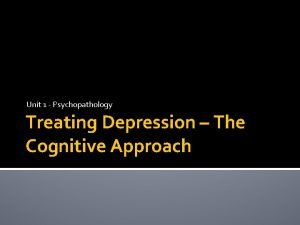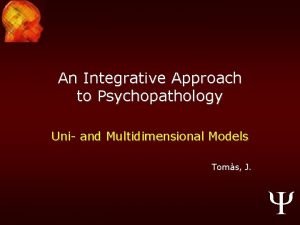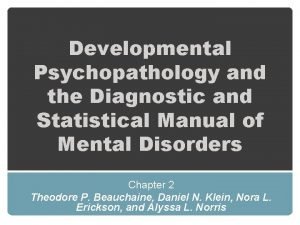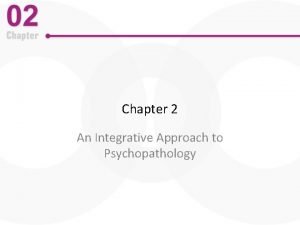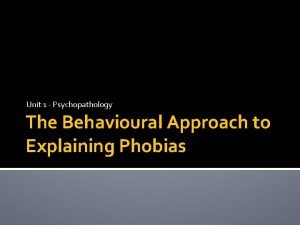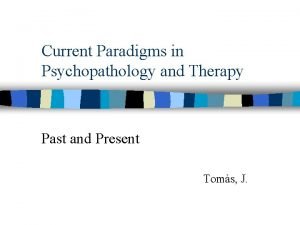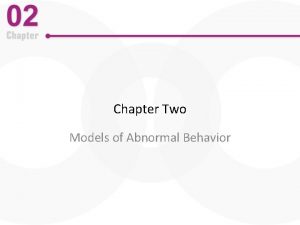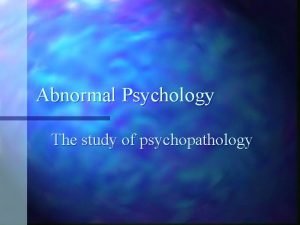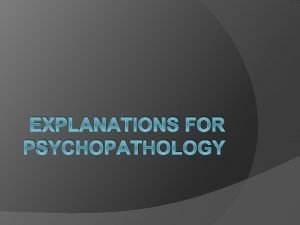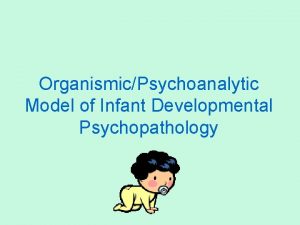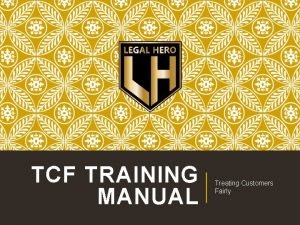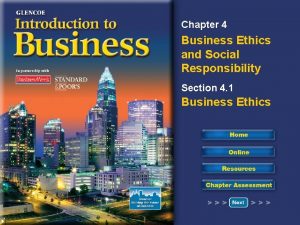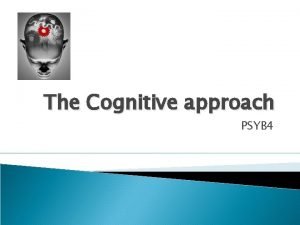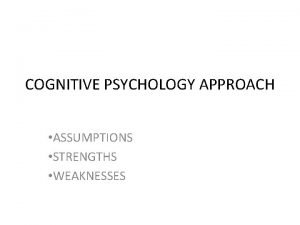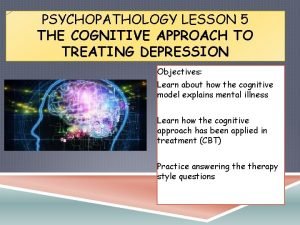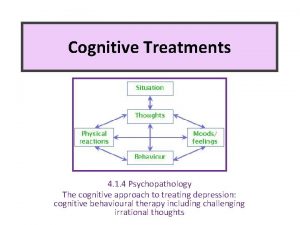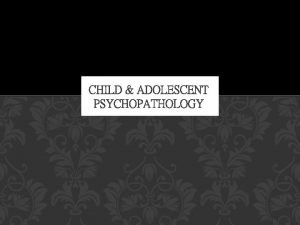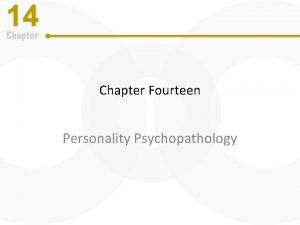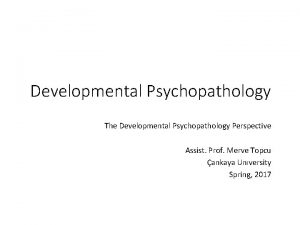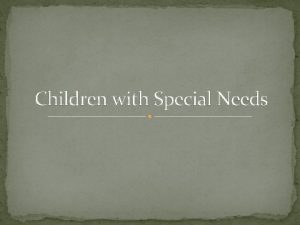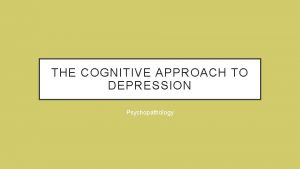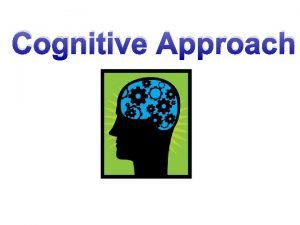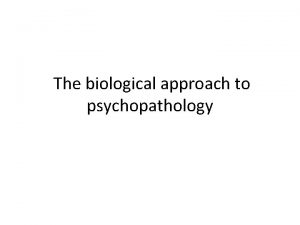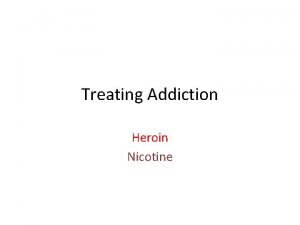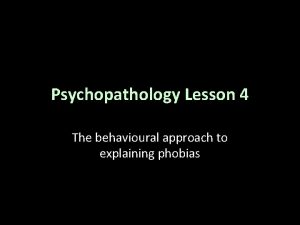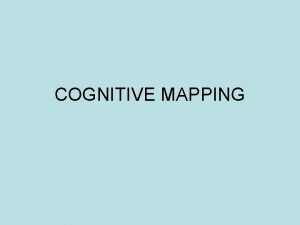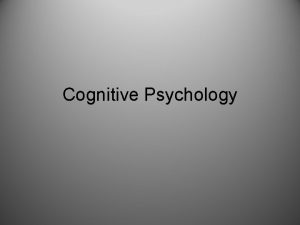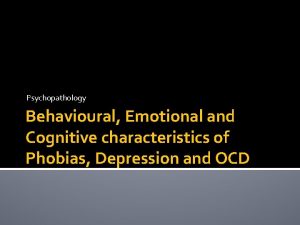PSYCHOPATHOLOGY LESSON 5 THE COGNITIVE APPROACH TO TREATING



























- Slides: 27

PSYCHOPATHOLOGY LESSON 5 THE COGNITIVE APPROACH TO TREATING DEPRESSION Objectives: Learn about how the cognitive model explains mental illness Learn how the cognitive approach has been applied in treatment (CBT) Practice answering therapy style questions

HOW DOES THE COGNITIVE APPROACH EXPLAIN ABNORMALITY? Abnormal behaviour is a direct result of faulty thinking. On your whiteboard… draw out the two models we used as explanations of depression.

BECK’S NEGATIVE TRIAD Beck (1987) believes people become depressed because the world is seen negatively through negative schemas. Negative schemas, together with cognitive biases/distortions, maintain the negative triad which sees negative thoughts being about…

WHAT’S THE DIFFERENCE BETWEEN THESE TWO THOUGHT PATTERNS?

COGNITIVE BEHAVIOUR THERAPY (CBT) CBT is the most commonly used psychological treatment for depression, as well as other mental health problems (e. g. anxiety, panic, phobias, stress, bulimia, OCD, Post-Traumatic Stress Disorder, bipolar disorder, etc. ) This is a method for treating mental disorders based on both behavioural and cognitive techniques The therapist aims to make the client aware of the relationship between thought, emotion and actions CBT can help people to change how they think (‘cognitive') and what they do (‘behaviour'). These changes can help them to feel better.

COGNITIVE BEHAVIOURAL THERAPY The aim of CBT is to challenge negative maladaptive thoughts and replace them with healthy thinking - often people are unaware that there is anything wrong with their thinking.

WHAT IS CBT? It is a way of talking (psychotherapy) about: how you think about yourself, the world and other people how what you do affects your thoughts and feelings. From the cognitive point of view therapy aims to deal with the thinking, such as challenging negative thoughts The therapy also includes behavioural techniques such as behavioural activation (encouraging patients to engage in those activities they are avoiding)

WHAT DOES CBT INVOLVE? The Sessions Meet with a therapist for between 5 and 20, weekly, or fortnightly sessions. Each session will last between 30 and 60 minutes. Some CBT therapists work with the techniques influenced by Beck and some work with the techniques influenced by Ellis. Most draw on both

Beck’s Cognitive Therapy Cognitive Behavioural Therapy • Stage 1 • Therapist & client agree on nature of problem & goals for therapy Stage 2 Therapist challenges the client’s negative thoughts Client engages in behaviour between sessions in an attempt to challenge these negative thoughts Beck Aim is for client to realise thoughts are irrational. Homework = diary kept

THOUGHTS INFLUENCE EMOTIONS AND BEHAVIOUR. To feel better you must think positively. The client is asked to provide information about how they perceive themselves, the future and the world. The therapist would use a process of reality testing e. g. if the client says, ‘I’m useless, and I always fail’, they will be asked whether in reality, they have been successful at something. The therapist might ask the client to do something to demonstrate their ability to succeed.

THE CLIENT’S BELIEFS ARE DIRECTLY CHALLENGED Clients are made aware of their negative views. In this way, irrational ideas can be replaced with more optimistic and rational beliefs. Through this process, irrational ideas can be replaced with more optimistic and balanced beliefs.

RESEARCH TO SUPPORT EFFECTIVENESS OF CBT (AO 3) (P) CBT is the most effective psychological treatment for moderate and severe depression. (E) Hollan et al (2006) investigated relapse rates for moderately to severely depressed patients treated with CBT for 16 weeks. He found a 40% relapse rate for CBT 45% relapse for anti-depressants 80% for placebo (E) This shows that CBT is slightly more effective, long term than drug therapy and much better than no treatment at all. (L) This shows that CBT works and is an effective therapy for depression. However, it may be advantageous to combine both CBT with anti-depressants for maximum success.

LIMITATION OF CBT (AO 3) (P) CBT is not useful for all patients (E) For example, CBT may be unsuitable for patients who have difficulty concentrating, which can be a symptom of people suffering depression. (E) This can lead to patients becoming overwhelmed and disappointed, which strengthens depressive symptoms rather than reducing them. (L) therefore, this shows that CBT can’t be applied to everyone and is not a ‘one size fits all’ approach to treating depression.

HOW EFFECTIVE IS CBT? CBT is effective in reducing symptoms of depression and in preventing relapse and there is a large body of evidence to support this (March et al, 2007) It is the most effective psychological treatment for moderate depression. It is as effective as antidepressants for many types of depression (Fava et al, 1994).

CBT 2 Ellis’ Rational Emotive Behaviour Therapy REBT extends the ABC model to an ABCDE model D = Dispute (challenge thoughts) E = Effect (see a more beneficial effect on thought and behaviour) Therefore the central technique of REBT is to identify and dispute the patient’s irrational thoughts

REBT Ellis (1962) argues that irrational thoughts are the main cause of all types of emotional distress and behaviour disorders. REBT is based on the premise that whenever we become upset, it is not the events taking place in our lives that upset us; it is the beliefs that we hold that cause us to become depressed, anxious, enraged, etc. Ellis believed that irrational beliefs make impossible demands on the individual, leading to anxiety, failure and psychological difficulty REBT challenges the client to prove these statements, and then replace them with more reasonable realistic statements (empirical disputing/logical disputing).

DISPUTING The goal of REBT is to help people change their irrational beliefs into rational beliefs. Changing beliefs is the real work of therapy and is achieved by therapist disputing the client's irrational beliefs. For example, therapist might ask, "Why must you win everyone's approval? " "Where is it written that other people must treat you fairly? " "Just because you want something, why must you have it? " Disputing is the D of the ABC model. When the client tries to answer therapist's questions, s/he sees that there is no reason why s/he absolutely must have approval, fair treatment, or anything else that s/he wants.

CHALLENGING DYSFUNCTIONAL THOUGHTS: • Ask self two questions • “Where is the evidence for X? ” • “What is the worst that can happen if X was true. ” • Automatic negative thought: I am going to fail psychology, and my life will be over! • What would be the response to the two questions?

ROLE PLAY TASK Role play in pairs. One person is the client; the other person is therapist. The therapist needs to use CBT principles to help first identify and then challenge the negative thoughts held by the client. Once you have done so, write down a sample of dialogue that demonstrates how CBT worked – remember the specific questioning style of therapist in stage one as well as the two particular questions used in stage 3.

Strengths Client is actively involved in their recovery CBT is not physically invasive Client learns to help themselves, and can use the skills in new situations. CBT works (research to support) Particularly when combined with drug treatment (Keller) Weaknesses Clients can become dependant on their therapist, or noncooperative CBT is not effective for people with rigid attitudes or resistance to change, or for people who have high stress levels in response to genuinely difficult life circumstances (depressive realism) CBT is not a quick fix. A therapist is like a personal trainer that advises and encourages - but cannot 'do' it for the client.

AO 3 Include one more AO 3 point from the book Make sure you PEEL.

1. Lucy is suffering from depression. She finds it hard to make new friends and finds any small challenges, such as paying bills, overwhelming. How might cognitive therapy be used to help Lucy overcome depression? (4 marks) Key words: CBT, reality testing, rational thoughts, REBT, identification

2. Gregg is addicted to gambling. He bets on races almost daily and is losing a lot of money this way. He feels he cannot go on in life without the money. How might cognitive therapy be used to help Gregg overcome his gambling addiction? (4 marks) Key words: CBT, reality testing, rational thoughts, REBT, identification

PLENARY Summarise CBT on your post it – include one strength and one weakness.

ESSAY Describe and evaluate cognitive behaviour therapy as a treatment for depression (12 marks – AS/16 marks A level)

IMPLICATIONS FOR THE ECONOMY 4. 2. 3. 1 Scientific processes: The implications of psychological research for the economy i. e. how knowledge of psychology is of benefit to employers Anything to do with treatment of mental disorders and people’s ability to work and contribute as effective members of society would be relevant - such as, finding an effective treatment (for any disorder) would reduce the number of days people have off work sick so improving productivity.

IMPLICATIONS FOR THE ECONOMY The World Health Organisation (WHO) have predicted that by 2020, depression will be the biggest single disease burden, costly to individuals, families, communities and the economy as a whole through lowered productivity, absenteeism and unemployment Therefore, if psychological research shows that people with a disorder such as depression are less likely to suffer a relapse after having cognitive therapy then, even though cognitive therapy might initially be more expensive than drug therapy, in the long-term it might be more economically sound to offer cognitive therapy as people would have less time off work.
 Cognitive approach to treating depression
Cognitive approach to treating depression Multidimensional integrative model
Multidimensional integrative model Developmental psychopathology approach
Developmental psychopathology approach Integrative approach to psychopathology
Integrative approach to psychopathology Mowrer's two process model
Mowrer's two process model Cognitive approach vs behavioral approach
Cognitive approach vs behavioral approach Bandura's reciprocal determinism
Bandura's reciprocal determinism Chapter 24 lesson 2 preventing and treating stds
Chapter 24 lesson 2 preventing and treating stds Current paradigms in psychopathology
Current paradigms in psychopathology Multipath model of abnormality
Multipath model of abnormality What is psychopathology
What is psychopathology Supernatural tradition of psychopathology
Supernatural tradition of psychopathology Speech errors examples
Speech errors examples Psychopathology
Psychopathology Cognitive and non cognitive religious language
Cognitive and non cognitive religious language Tumor treating fields mechanism of action
Tumor treating fields mechanism of action Ethical issues in treating lgbt patients
Ethical issues in treating lgbt patients Treating customers fairly training
Treating customers fairly training Bulk heat treatment
Bulk heat treatment How can treating an employee unethically backfire
How can treating an employee unethically backfire Essay cognitive psychology
Essay cognitive psychology Cognitive approach assumptions
Cognitive approach assumptions Personality construct examples
Personality construct examples Reciprocal determinism definition psychology
Reciprocal determinism definition psychology Thinking humanly: the cognitive modeling approach
Thinking humanly: the cognitive modeling approach Affective objectives in lesson plan example
Affective objectives in lesson plan example Virtual circuit vs datagram networks
Virtual circuit vs datagram networks International market selection
International market selection
